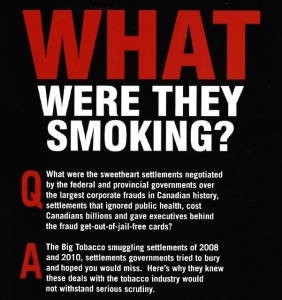Garfield Mahood
President, Campaign for Justice on Tobacco Fraud

In the early 1980’s, Canada had one of the globe’s highest rates of per capita tobacco consumption. But in less than two decades, in response to aggressive campaigning by health NGOs, Canada experienced arguably the largest decline in use anywhere.
Gains were made on many fronts: through increases in tobacco taxation, a world precedent-setting ban on tobacco advertising, breakthroughs in smoke-free air travel and federally-regulated workplaces, and from landmark tobacco package warnings.
But Canada can no longer claim that it is at the forefront of responses to the tobacco epidemic. In 2010, the neo-liberal federal government cancelled longstanding plans for a renewal of stale package warnings. Then, in the face of fierce opposition, it reversed itself and a year later mandated new warnings which discarded several of the precedent-setting elements of Canada’s ground-breaking 1994 and 2001 warning systems.
Then, the health minister cancelled the entire grants and contributions component of the national tobacco strategy. This cut millions of dollars of funding from troublesome NGOs which had pressed the government to produce the up-dated warnings. Needless to say, plain packaging is no longer on the government’s agenda.
One of the most severe criticisms of the federal government, said Western University law professor Robert Solomon, “stems from the sweetheart tobacco smuggling settlements that it negotiated with Big Tobacco in 2008 and 2010. In those settlements, health remedies to deal with the illness caused by the smuggling fraud appear not to have been given any consideration.”
Unlike American tobacco litigation, criminal investigations and civil lawsuits in Canada produced settlements of pennies on the dollars claimed, no disclosure of industry documents and no real incentives for the manufacturers to change their behaviour. Tobacco executives facing jail time had their charges stayed.
According to William Marsden of Montreal’s The Gazette, the tobacco executive who planned much of the smuggling told him that the federal police knew “all about this. They could have walked in and just handcuffed everybody at Imperial [Canada’s largest tobacco company. The government]…did not have the guts of a field mouse to go after the executives of the company….”
Now, Canada’s provinces are suing tobacco manufacturers and their international parents to recover the health care costs associated with smoking which resulted from industry fraud and conspiracy over five decades. The governments allege that the companies involved lied about risks, addiction, ‘light’ and ‘mild’ cigarettes, and second-hand smoke.
The claims filed to date by nine provinces exceed CDN $110 billion. If this wrongful behaviour is proven in court, as it was in the USA, it will constitute the largest fraud in the history of Canadian business. It certainly was the most destructive with estimates that industry deception caused or contributed to up to two million deaths in Canada since 1964.
The smuggling settlements trivialized the harms caused by the fraud. So the Campaign for Justice on Tobacco Fraud (CJTF) was incorporated, to advocate for positive health outcomes from the health care cost recovery litigation.
As mentioned in the September 2014 Tobacco Control, the CJTF pressed provincial and territorial governments to take Big Tobacco to trial, insist on the disclosure of industry documents, and allocate a significant portion of monies recovered to an arms-length-from-government agency with a mandate to reduce tobacco industry-caused disease. The CJTF submission was signed by the heads of 60 health organizations, by the deans of schools of public health, and by professors of medicine and law, 137 signatories in all.
It will take a determined health community to put public health into the litigation deliberations and to offset years of federal government back-sliding.